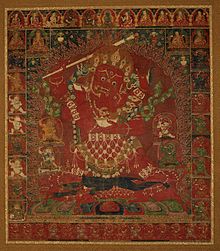

Rakta Yamari (Tibetan shin je she mar in, Wylie: gshin rje gshed dmar "the Red Enemy of Death") is a Tantric Buddhist meditational deity which is a wrathful form of bodhisattva Manjushri or Yamantaka. Yamari deities have two forms: red (rakta) and black (krishna), and are part of the Anuttarayoga Class of Tantric Buddhism.
The Ngor Mandala collection of the Sakya tradition alone lists eight different forms/lineages of the blue/black buffalo-faced Vajrabhairava (which include the two Gelug ones) and four of red Rakta- or blue Krishna-Yamari (all without the buffalo head). All the former are yidams (meditational deities) whereas Yamaraja (sometimes also called Dharamaraja) is a Dharma protector.
Rakta Yamari of Virupa and Rakta Yamari of Shridhara appear in chapter 8 of The Collection of All Tantras, compiled by Jamyang Khyentse Wangpo and Jamyang Loter Wangpo.
References
- "Rakta Yamari". Himalayan Buddhist Art - Art Bouddhiste de l'Himalaya. 2013-02-14. Retrieved 2014-02-13.
- "Rakta Yamari - Updated". Himalayan Art News. 2011-08-22. Retrieved 2014-02-13.
- "Rakta Yamari in Consort with Svabha-Prajna Central Tibetan, probably Tsang, Second quarter of the 15th century". Museum of Fine Arts, Boston. Retrieved 2014-02-13.
- Gonsalez, David (2004-06-12). "Vajrabhairava / Yamantaka - An Introduction". Yamantaka.org. Archived from the original on 2014-02-21. Retrieved 2014-02-13.
- "rgyud sde kun btus". Rangjung Yeshe Wiki - Dharma Dictionnary. Retrieved 2014-02-13.
External links
- "Rakta Yamari Grand Puja 2007 (May) - Poster & Write-up". Vajrayana Buddhist Society. 2009-10-20. Retrieved 2014-02-13.
- "A Gilt Bronze Figure of Rakta Yamari, TIBET, 14TH CENTURY, Indian & Southeast Asian Art Auction, Sculptures, Statues & Figures, figure". Christie's. 2009-03-20. Retrieved 2014-02-13.
- "9. Rakta-Yamari Tibet 15th century Gilt copper, silver, iron, turquoise, lapis lazuli and painted details". Cast for Eternity: Bronze Masterworks from India and the Himalayas. 2005. Retrieved 2014-02-13.
This Buddhist mythology-related article is a stub. You can help Misplaced Pages by expanding it. |
This Tibet-related article is a stub. You can help Misplaced Pages by expanding it. |